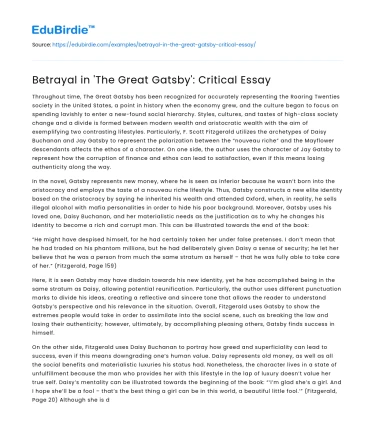Throughout time, The Great Gatsby has been recognized for accurately representing the Roaring Twenties society in the United States, a point in history when the economy grew, and the culture began to focus on spending lavishly to enter a new-found social hierarchy. Styles, cultures, and tastes of high-class society change and a divide is formed between modern wealth and aristocratic wealth with the aim of exemplifying two contrasting lifestyles. Particularly, F. Scott Fitzgerald utilizes the archetypes of Daisy Buchanan and Jay Gatsby to represent the polarization between the “nouveau riche” and the Mayflower descendants affects the ethos of a character. On one side, the author uses the character of Jay Gatsby to represent how the corruption of finance and ethos can lead to satisfaction, even if this means losing authenticity along the way.
In the novel, Gatsby represents new money, where he is seen as inferior because he wasn’t born into the aristocracy and employs the taste of a nouveau riche lifestyle. Thus, Gatsby constructs a new elite identity based on the aristocracy by saying he inherited his wealth and attended Oxford, when, in reality, he sells illegal alcohol with mafia personalities in order to hide his poor background. Moreover, Gatsby uses his loved one, Daisy Buchanan, and her materialistic needs as the justification as to why he changes his identity to become a rich and corrupt man. This can be illustrated towards the end of the book:
Save your time!
We can take care of your essay
- Proper editing and formatting
- Free revision, title page, and bibliography
- Flexible prices and money-back guarantee
“He might have despised himself, for he had certainly taken her under false pretenses. I don’t mean that he had traded on his phantom millions, but he had deliberately given Daisy a sense of security; he let her believe that he was a person from much the same stratum as herself – that he was fully able to take care of her.” (Fitzgerald, Page 159)
Here, it is seen Gatsby may have disdain towards his new identity, yet he has accomplished being in the same stratum as Daisy, allowing potential reunification. Particularly, the author uses different punctuation marks to divide his ideas, creating a reflective and sincere tone that allows the reader to understand Gatsby’s perspective and his relevance in the situation. Overall, Fitzgerald uses Gatsby to show the extremes people would take in order to assimilate into the social scene, such as breaking the law and losing their authenticity; however, ultimately, by accomplishing pleasing others, Gatsby finds success in himself.
On the other side, Fitzgerald uses Daisy Buchanan to portray how greed and superficiality can lead to success, even if this means downgrading one’s human value. Daisy represents old money, as well as all the social benefits and materialistic luxuries his status had. Nonetheless, the character lives in a state of unfulfillment because the man who provides her with this lifestyle in the lap of luxury doesn’t value her true self. Daisy’s mentality can be illustrated towards the beginning of the book: “‘I’m glad she’s a girl. And I hope she’ll be a fool – that’s the best thing a girl can be in this world, a beautiful little fool.’” (Fitzgerald, Page 20) Although she is discussing her daughter, Daisy is implying, in her own life, in order to be happy, a woman needs to be beautiful and a fool. Because her husband, Tom Buchanan, is far from faithful, Daisy believes if she acted as a fool, she wouldn’t be aware of the infidelity and would joyously continue to enjoy her opulent and carefree experience. Likewise, her beauty is what Tom found attractive, allowing her to thrive in the controlled environment the wealth provides. With the preciseness Fitzgerald uses, the reader understands Daisy’s mindset is indifferent towards change, implicitly stating she would rather superficially live in a high social status where she’s looked up to than have a life where her feelings, opinions, and values are taken into consideration.
Despite the contrast given between both socioeconomic groups, Fitzgerald uses the characters of Gatsby and Daisy to illustrate the overall moral failings of a society driven by wealth in the 1920s. Both protagonists certainly represent distinctive values due to their background variations. Nevertheless, they share predominant values of betrayal influence a majority of their actions, as seen in the dinner party’s public displays of affection “As he left the room again, she got up and went over to Gatsby and pulled his face down kissing him on the mouth. ‘You know I love you,’ she murmured” (Fitzgerald, Page 123). Daisy and Gatsby’s most prominent disloyalty occurred during the affair while she was still married to Tom, where their selfish desires clouded moral reason. Neither Gatsby nor Daisy feels somewhat guilty about the infidelity, representing their lack of interest in the consequences their actions may bring. In Daisy’s case, she coerced Gatsby into believing she loved only him, and they would be together, despite the fact she was married and had no plans to leave Tom Buchanan. Nonetheless, she decided to turn her back on Gatsby and return to her blue-blooded husband, and once Gatsby died, she didn’t even care to attend his funeral. Gatsby didn’t only betray his ethical standards but also himself. He could’ve reached new heights with his casual demeanor and love for the theatrical. However, he lost all of his potential, and even his life, by following Daisy’s caprices rather than his.
After thoroughly analyzing and understanding the social stratification and its implications within The Great Gatsby, it can be concluded Daisy’s high-class society is motivated by wealth, while low-class descendants such as Gatsby are driven by emotion and human value due to their lack of capital stimulus. As a result, none of the characters accomplished to be neither successful nor satisfied, contributing to Fitzgerald’s overall message: an immoral lifestyle will lead you to an unhappy and tragic ending.






 Stuck on your essay?
Stuck on your essay?

